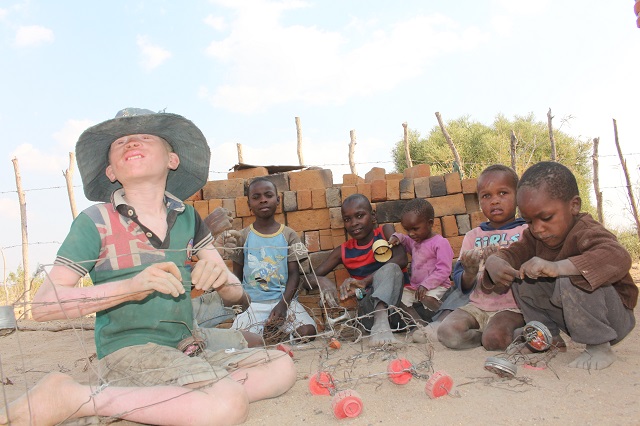They call me Thamsanqa, l am an albino

Feature, Mkhululi Ncube and Crystabel Chikayi
AT the sight of a little boy with peeled skin, Gogo Cynthia Moyo chickened out. She had never seen such “abomination” all her life, let alone in Gwambe village, Bulilima District, Matabeleland South province.
Her nights turned into a horror set. She saw the peeled boy every night in her dreams and would jump out of bed with a scream so loud it would wake up everyone in the house.
The sight of the boy gave Gogo Moyo heebie-jeebies; she had hallucinations.
“The child turned me into a bundle of nerves. He scared me greatly. I’d never seen anyone like him in my life time. I failed to understand what he was or what went wrong during his conception.
“I hardly slept; the boy visited my dreams every night. I had feel shivers running down my spine. I would have blared visions of him standing in the room looking at me,” said Gogo Moyo, who is grandmother to Thamsanqa Vundla, an 11-year-old boy living with albinism.
She said as a grandmother, she never helped nurse the boy when he was young.
“I wanted us to report the birth to our chief and let him know an uncommon creature had been born into our family.
“I was scared of what the villagers were going to say when they saw the child. But the boy’s grandfather convinced me that the boy had albinism, which is a common condition,” said Gogo Moyo.
“Thamsanqa is the only grandchild I never nursed. I couldn’t hold him even when he cried, or change his nappies, or even get near him. I would watch his mother and her sister help each other nurse him. It took a very long time for me to accept him as a normal child,” said Gogo Moyo.
Thamsanqa’s mother, Miss Precious Moyo, said moments after giving birth to her son and holding him in her hands — she felt scared.
Fear of what the in-laws would say gripped her but she remained courageous as she had seen people living with albinism before.
Miss Moyo has four children and Thamsanqa is the only one living with albinism.
She said fellow villagers came up with countless theories as to why she had given birth to a child with albinism.
“When I had finally accepted that I’d given birth to a child with albinism, rumours started circulating. The rumours said a child with albinism is born when a woman practices bestiality.
“Some went on to say I had slept with a snake. But my in-laws understood the condition and didn’t read much into the rumours. My brother-in-law is the one who named the child Thamsanqa,” said Miss Moyo.
She said taking care of a baby with albinism was challenging as she had no knowledge of the condition.
And now, 11 years later, Miss Moyo said it is still hard taking care of a child living with albinism especially in a place such as Plumtree where temperatures are usually very high as the place is close to the Kalahari desert in Botswana.
“I experience numerous difficulties because my son needs extra care. It gets very hot in our region and when it does, he develops wounds and cracks on his skin. His lips, hands and legs turn red and he cries in anguish at night.
“I didn’t know how to deal with these wounds so I’d give him a cold bath and apply aqueous cream all over his body. When I took him to the clinic, the nurses gave me sun protection cream which helped shield him from the effects of the sun’s rays.
“Now, I don’t have the sun screen lotion and I can’t afford to buy some,” she said.
Had it not been the school head of Gwambe Primary School, Mr Chadrek Nkobi, Thamsanqa would still not be in school.
By mere chance — which would change his life drastically, Mr Nkobi bumped into the boy, who was crossing the road while he drove past, and inquired why he was not in school since he was of school-going age.
“I saw the boy crossing the road when I was coming from work and I realised he was of school-going age but I had never seen him at the school.
Due to my inquisitive mind, I stopped the boy to ask why he wasn’t in school.
“I looked for his parents and convinced them to bring him to school even if they had no school fees for him,” said Mr Nkobi.
Despite encouragement from the school head, Miss Moyo said she felt more comfortable having her son at home instead of taking him to school as she was scared other children would ill-treat and make fun of him as she had observed when he was playing with other children from the neighbourhood.
“Thamsanqa went to school late because I was afraid of the way other children would treat him. I was scared that he would be isolated. When the school head finally convinced me to take Thamsanqa to school, he came back home saying they were calling him inkawu (monkey), just as I had anticipated,” said Miss Moyo.
Although Thamsanqa eventually saw the walls of a classroom, he had a tough time adjusting to school life as other children were scared of him.
They had never seen a person living with albinism before.
Mr Nkobi said it took the other pupils a while for them to get used to having Thamsanqa around. The kids were scared of him.
“I introduced Thamsanqa to the school while holding his hand so that the children could see that he is harmless.
“The biggest problem was in his classroom. His classmates would run from him and squash each other in one corner because they were afraid of him.
“Some children even cried in class when he was around. To make matters worse, his teacher was also afraid of him as she had never had a close encounter with a person living with albinism. But they later got used to him and now he is playing and enjoying like the rest of the pupils,” said Mr Nkobi.
He said Thamsanqa has potential to excel in school but has challenges with his eyesight.
“The school does what it can to make Thamsanqa feel comfortable at school. All the teachers know that he is not supposed to remove his hat so that he is well protected from the sun.
“Our biggest challenge right now is that of his eyesight. When in class, he can hardly read what is written on the chalkboard. He sometimes just listens to his teacher and not follow illustrations on the board,” said Mr Nkobi.
Miss Moyo works at a retail shop in the village and she earns very little and as such cannot provide even the basics required by Thamsanqa and her other three children.
She survives from hand to mouth and said her ex-husband only sends money after a long time which in most cases is not enough.
Thamsanqa is Xhosa meaning “good fortune” which is ironic given the challenges his parents and the boy himself have gone through since his birth.










Comments